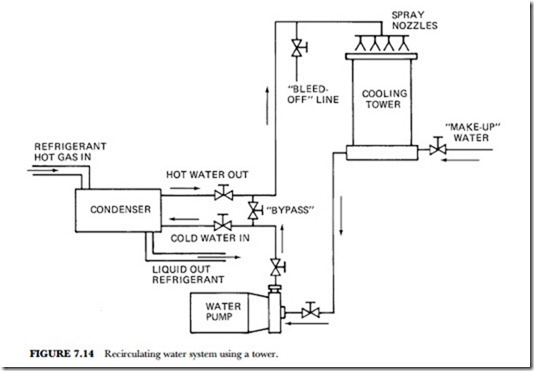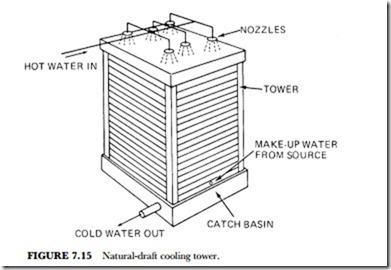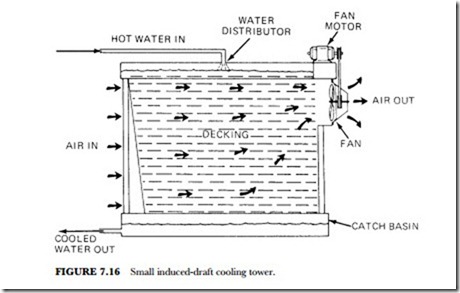COOLING TOWERS
Cooling towers are used to conserve or recover water. In one design the hot water from the condenser is pumped to the tower. There, it is sprayed into the tower basin. The temperature of the water decreases as
it gives up heat to the air circulating through the tower. Some of the towers are rather large, since they work with condensers yielding 1,600 tons of cooling capacity. (See Figure 7.14.) Most of the cooling that takes place in the tower results from the evaporation of part of the water as it falls through the tower. The lower the wet bulb temperature of the incoming air, the more efficient the air is in decreasing the temperature of the water being fed into the tower. The following factors influence the efficiency of the cooling tower:
• Mean difference between vapor pressure of the air and pressure in the tower water
• Length of exposure time and amount of water surface exposed to air
• Velocity of air through the tower
• Direction of air flow relative to the exposed water surface (parallel, transverse, or counter)
Theoretically, the lowest temperature to which the water can be cooled is the temperature of the air (wet bulb) entering the tower. However, in practical terms it is impossible to reach the temperature of the air. In most instances, the temperature of the water leaving the tower will be no lower than 7 to 10 degrees F (4 to 6 degrees C) above the air temperature.
The range of the tower is the temperature of the water going into the tower and the temperature of the water coming out of the tower. This range should be matched to the operation of the condenser for maxi- mum efficiency.
Cooling-Systems Terms
The following terms apply to cooling tower systems.
Cooling range is the number of degrees Fahrenheit through which the water is cooled in the tower. It
is the difference between the temperature of the hot water entering the tower and the temperature of the
Approach is the difference in degrees Fahrenheit between the temperature of the cold water leaving the cooling tower and the wet-bulb temperature of the surrounding air.
Heat load is the amount of heat “thrown away” by the cooling tower in Btu per hour (or per minute). It
is equal to the pounds of water circulated multiplied by the cooling range.
Cooling-tower pump head is the pressure required to lift the returning hot water from a point level
with the base of the tower to the top of the tower and force it through the distribution system.
Drift is the small amount of water lost in the form of fine droplets retained by the circulating air. It is in-
dependent of and in addition to evaporation loss.
Bleed-off is the continuous or intermittent wasting of a small fraction of circulating water to prevent the
buildup and concentration of scale-forming chemicals in the water.
Makeup is the water required to replace the water that is lost by evaporation, drift, and bleed-off.
Design of Cooling Towers
Classified by the air-circulation method used, there are two types of cooling towers: natural-draft or me- chanical-draft. Figure 7.15 shows the operation of the natural-draft cooling tower, and Figure 7.16 shows the operation of the mechanical-draft cooling tower. The forced-draft cooling tower shown in Figure 7.17 is just one example of the mechanical-draft designs available today.
Cooling-tower ratings are given in tons. This is based on heat-transfer capacity of 250 Btu per minute per ton. The normal wind velocity taken into consideration for tower design is 3 miles per hour. The wet-bulb temperature is usually 80 degrees F (27 degrees C) for design purposes. The usual flow of water over the tower is 4 gallons per minute for each ton of cooling desired. Several charts are available showing current design technology. Manufacturers supply the specifications for their towers. However, there are some important points to remember when use of a tower is being considered:
• In tons of cooling, the tower should be rated at the same capacity as the condenser
• The wet-bulb temperature must be known
• The temperature of the water leaving the tower and entering the condenser should be known
Towers present some maintenance problems. These stem primarily from the water used in the cooling system. Chemicals are employed to control the growth of bacteria and other substances. Scale in the pipes and on parts of the tower must also be controlled. Chemicals are used for each of these controls.


